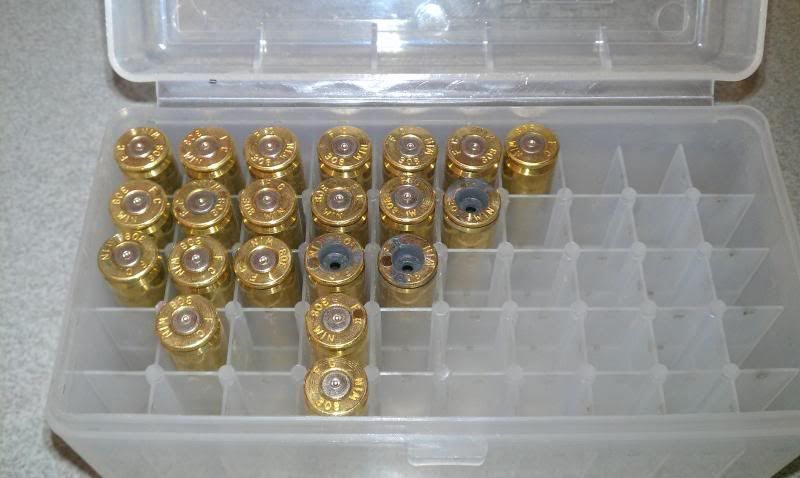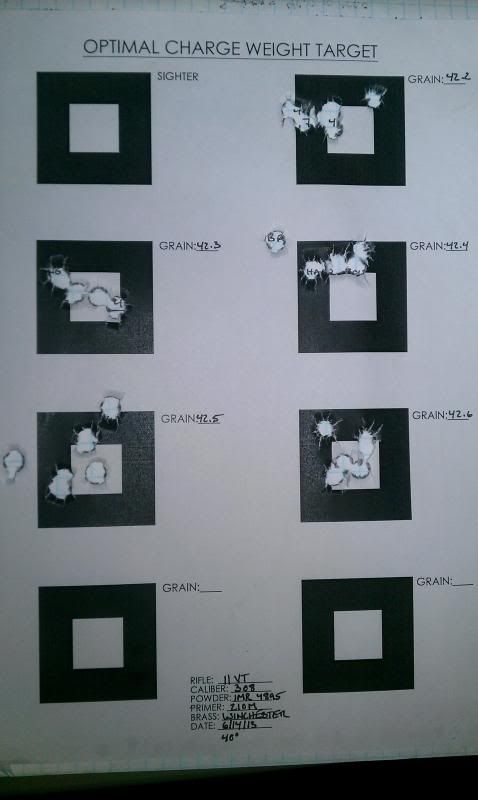I had a chance to shoot my first optimal charge weight test today with a buddy who has been reloading for years (I’m new to this).
Savage 11 chambered in .308
IMR 4895
SMK 175
FC Brass
Federal 210M primers
COAL 2.805
Ambient temp was 71* climbing up to 75*
The results have me confused and worried. I noticed what looked like an ejector pin mark on the first round of the fourth charge weight (shooting round robin). My buddy asked if I got any resistance lifting the bolt on that round. I said no, he said proceed. We got through all 7 of the first rounds with no problem and started on the second rounds.
At the second round of the 6th charge weight, the primer popped. I was very nervous, didn't like that at all. But we pulled the bolt and didn’t see any damage. Buddy asks about bolt lift, it was normal. No resistance. Gladly, we didn’t fire the second round of the 7th charge weight. He talks me into firing the third round of charge weights stopping at the 5th charge weight. I had primers pop on both the 4th and 5th charge weights.
I’m using once fired (according to the guy I bought them from) FC brass which I’ve read can be soft and have loose primer pockets. I’m not comfortable at all with these popped primers and plan on having a gun smith look at the gun to make sure there is no damage. Looking at what I ended up with on paper, if I were to pursue these weights, I think I’d develop around 42.2 grains and 42.7 grains, but I’d buy some Winchester or Lapua brass first.
Or, I could start all over with a new max weight and keep the FC brass. I had picked 43.5 grains as my max which was still in the safe range according to IMR’s data, and pushing it according to my Lyman book/pamphlet. Sierra suggests a range of 36.7 to 41.5. If I were to start over, maybe I should use the 41.5 max.
I realize I’m rambling, so I guess my question is; should I use better brass, reduce my charge weights and start over, or both?
Also, I think I should have stopped when I saw ejector pin marks, but he says they’re not that deep and points out that I had normal bolt lift. He believes the problem was bad brass or bad primers and that the popped primers couldn't have been foreseen. Is that right?


Savage 11 chambered in .308
IMR 4895
SMK 175
FC Brass
Federal 210M primers
COAL 2.805
Ambient temp was 71* climbing up to 75*
The results have me confused and worried. I noticed what looked like an ejector pin mark on the first round of the fourth charge weight (shooting round robin). My buddy asked if I got any resistance lifting the bolt on that round. I said no, he said proceed. We got through all 7 of the first rounds with no problem and started on the second rounds.
At the second round of the 6th charge weight, the primer popped. I was very nervous, didn't like that at all. But we pulled the bolt and didn’t see any damage. Buddy asks about bolt lift, it was normal. No resistance. Gladly, we didn’t fire the second round of the 7th charge weight. He talks me into firing the third round of charge weights stopping at the 5th charge weight. I had primers pop on both the 4th and 5th charge weights.
I’m using once fired (according to the guy I bought them from) FC brass which I’ve read can be soft and have loose primer pockets. I’m not comfortable at all with these popped primers and plan on having a gun smith look at the gun to make sure there is no damage. Looking at what I ended up with on paper, if I were to pursue these weights, I think I’d develop around 42.2 grains and 42.7 grains, but I’d buy some Winchester or Lapua brass first.
Or, I could start all over with a new max weight and keep the FC brass. I had picked 43.5 grains as my max which was still in the safe range according to IMR’s data, and pushing it according to my Lyman book/pamphlet. Sierra suggests a range of 36.7 to 41.5. If I were to start over, maybe I should use the 41.5 max.
I realize I’m rambling, so I guess my question is; should I use better brass, reduce my charge weights and start over, or both?
Also, I think I should have stopped when I saw ejector pin marks, but he says they’re not that deep and points out that I had normal bolt lift. He believes the problem was bad brass or bad primers and that the popped primers couldn't have been foreseen. Is that right?




